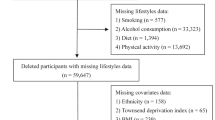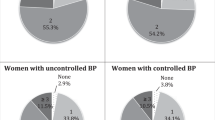Abstract
Background: Cardiovascular disease represents one of the most important causes of morbidity and mortality in highly developed countries and is known to be associated with some lifestyle-related risk factors (e.g. alcohol consumption, smoking status, diet, physical activity, bodyweight). There is still incomplete information about their combined effect on cardiovascular risk in hypertensive patients with optimal pharmacological blood pressure control.
Aim: The objective of this study was to evaluate the correlation of some lifestyle behaviours, using a specific questionnaire, with development of cardiovascular disease in treated hypertensive patients.
Methods: 617 hypertensive, non-diabetic participants (aged 53.1±7.6 years, 44.9% male; mean age 53.1±7.6 years) free of prevalent cardiovascular disease, cancer, liver cirrhosis and/or failure, chronic kidney disease more than grade 3 (glomerular filtration rate by the Modification of Diet in Renal Disease study <30 mL/min/1.73 m2) were analysed. Metabolic syndrome was defined according to the Third Report of the Expert Panel on Detection, Evaluation, and Treatment of High Blood Cholesterol in Adults (Adult Treatment Panel III). Left ventricular hypertrophy was defined when left ventricular mass index was >51 g/m2. Carotid artery atherosclerosis was assessed as an increased intima medial thickness (IMT) by B-mode ultrasonography. IMT values between 0.9 and 1.3 mm were defined as ‘thickening’ and those >1.3 mm as ‘plaque’.
Assessment of smoking status, dietary and non-dietary factors was established by administration of a specific questionnaire.
Results: In the initial population of examined patients, 288 were smokers and 329 were non-smokers. At baseline, the patients belonging to smoking group were less often overweight than those belonging to the non-smoking group, showing a lower initial body mass index (BMI) [27.54±4.0 vs 28.28±4.3; p<0.029], lower plasma levels of high-density lipoprotein cholesterol (HDL-C) [48.14±12.6 vs 51.39±14.1 mg/dL; p<0.006] and were more often affected by carotid artery atherosclerosis (93.9 % vs 86.1%; p<0.002) than non-smoking patients.
When analysed for dietary and other lifestyle-related risk factors, we found a higher prevalence of carotid atherosclerotic disease in patients consuming less than two meals per day than in those consuming more than two meals per day (96.6% vs 85.7%; p<0.001), without any significant difference in the mean number of medications taken and in specific classes of medications.
Total amount of cigarettes smoked, calculated as packs per year (39.14±16.5 vs 20.81±13.6; p<0.0001) was higher in patients with a diagnosis of atherosclerotic disease of the carotid artery than in patients free of this disorder, whereas the average age at which people began smoking was lower (17.58±6.3 vs 21.53±10.2 years). In a binary model of logistic regression adjusted for BMI, HDL-C, smoking status and number of daily meals, only smoking status was confirmed to be strongly correlated to clinical evidence of carotid atherosclerosis (p<0.025).
Conclusions: In hypertensive patients, in optimal blood pressure control, smoking status has been shown to be independently associated with an increased maximum arterial IMT (IMTmax). In particular, an increase of the IMT was associated with the total amount of cigarettes smoked (calculated as packs per year) and the average age at which people began smoking.






Similar content being viewed by others
References
Lakka HM, Laaksonen DE, Lakka TA, et al. The metabolic syndrome and total and cardiovascular disease mortality in middle-aged men. JAMA 2002 Dec 4; 288 (21): 2709–16.
Kawachi I, Colditz GA, Stampfer MJ, et al. Smoking cessation in relation to total mortality rates in women: a prospective cohort study. Ann Intern Med 1993 Nov 15; 119 (10): 992–1000.
Izzo R, Di Renzo G, De Luca N, et al. Smoking selectively accelerates carotid atherosclerosis in hypertensive patients. High Blood Press Cardiovasc Prev 2008; 15 (4): 269–73.
Thun MJ, Peto R, Lopez AD, et al. Alcohol consumption and mortality among middle-aged and elderly US adults. N Engl J Med 1997 Dec 11; 337 (24): 1705–14.
O’Donnell MJ, Xavier D, Liu L, et al. Risk factors for ischaemic and in-tracerebral haemorrhagic stroke in 22 countries (the INTERSTROKE study): a case-control study. Lancet 2010 Jul 10; 376 (9735): 112–23.
Pate RR, Pratt M, Blair SN, et al. Physical activity and public health: a recommendation from the Centers for Disease Control and Prevention and the American College of Sports Medicine. JAMA 1995 Feb 1; 273 (5): 402–7.
Albert CM, Hennekens CH, O’Donnell CJ, et al. Fish consumption and risk of sudden cardiac death. JAMA 1998 Jan 7; 279 (1): 23–8.
Hu FB, Stampfer MJ, Manson JE, et al. Dietary fat intake and the risk of coronary heart disease in women. N Engl J Med 1997 Nov 20; 337 (21): 1491–9.
Liu S, Willett WC, Stampfer MJ, et al. A prospective study of dietary glycemic load, carbohydrate intake, and risk of coronary heart disease in US women. Am J Clin Nutr 2000 Jun; 71 (6): 1455–61.
Rimm EB, Willett WC, Hu FB, et al. Folate and vitamin B6 from diet and supplements in relation to risk of coronary heart disease among women. JAMA 1998 Feb 4; 279 (5): 359–64.
Willett WC, Stampfer MJ, Manson JE, et al. Intake of trans fatty acids and risk of coronary heart disease among women. Lancet 1993 Mar 6; 341 (8845): 581–5.
Wolk A, Manson JE, Stampfer MJ, et al. Long-term intake of dietary fiber and decreased risk of coronary heart disease among women. JAMA 1999 Jun 2; 281 (21): 1998–2004.
De Luca N, Izzo R, Iaccarino G, et al. The use of a telematic connection for the follow-up of hypertensive patients improves the cardiovascular prognosis. J Hypertens 2005 Jul; 23 (7): 1417–23.
Izzo R, de Simone G, Chinali M, et al. Insufficient control of blood pressure and incident diabetes. Diabetes Care 2009 May; 32 (5): 845–50.
Mancia G, De Backer G, Dominiczak A, et al. 2007 Guidelines for the management of arterial hypertension: the Task Force for the Management of Arterial Hypertension of the European Society of Hypertension (ESH) and of the European Society of Cardiology (ESC). J Hypertens 2007 Jun; 25 (6): 1105–87.
Sahn DJ, DeMaria A, Kisslo J, et al. Recommendations regarding quantitation in M-mode echocardiography: results of a survey of echocardiographic measurements. Circulation 1978 Dec; 58 (6): 1072–83.
Devereux RB, Reichek N. Echocardiographic determination of left ventricular mass in man: anatomic validation of the method. Circulation 1977 Apr; 55 (4): 613–8.
de Luca N, Asmar RG, London GM, et al. Selective reduction of cardiac mass and central blood pressure on low-dose combination perindopril/indapamide in hypertensive subjects. J Hypertens 2004 Aug; 22 (8): 1623–30.
Lang RM, Bierig M, Devereux RB, et al. Recommendations for chamber quantification: a report from the American Society of Echocardiography’s Guidelines and Standards Committee and the Chamber Quantification Writing Group, developed in conjunction with the European Association of Echocardiography, a branch of the European Society of Cardiology. J Am Soc Echocardiogr 2005 Dec; 18 (12): 1440–63.
Devereux RB, Alonso DR, Lutas EM, et al. Echocardiographic assessment of left ventricular hypertrophy: comparison to necropsy findings. Am J Cardiol 1986 Feb 15; 57 (6): 450–8.
Lembo G, De Luca N, Battagli C, et al. A common variant of endothelial nitric oxide synthase (Glu298Asp) is an independent risk factor for carotid atherosclerosis. Stroke 2001 Mar; 32 (3): 735–40.
Lorenz MW, Markus HS, Bots ML, et al. Prediction of clinical cardiovascular events with carotid intima-media thickness: a systematic review and meta-analysis. Circulation 2007 Jan 30; 115 (4): 459–67.
Roman MJ, Naqvi TZ, Gardin JM, et al. Clinical application of noninvasive vascular ultrasound in cardiovascular risk stratification: a report from the American Society of Echocardiography and the Society for Vascular Medicine and Biology. Vasc Med 2006 Nov; 11 (3): 201–11.
Femia R, Kozakova M, Nannipieri M, et al. Carotid intima-media thickness in confirmed prehypertensive subjects: predictors and progression. Arterioscler Thromb Vasc Biol 2007 Oct; 27 (10): 2244–9.
Stubbe I, Eskilsson J, Nilsson-Ehle P. High-density lipoprotein concentrations increase after stopping smoking. BMJ (Clin Res Ed) 1982 May 22; 284 (6328): 1511–3.
Axelsen M, Eliasson B, Joheim E, et al. Lipid intolerance in smokers. J Intern Med 1995 May; 237 (5): 449–55.
Fabry P, Hejl Z, Fodor J, et al. The frequency of meals. its relation to overweight, hypercholesterolaemia, and decreased glucose-tolerance. Lancet 1964 Sep 19; 2 (7360): 614–5.
Edelstein SL, Barrett-Connor EL, Wingard DL, et al. Increased meal frequency associated with decreased cholesterol concentrations; Rancho Bernardo, CA, 1984–1987. Am J Clin Nutr 1992 Mar; 55 (3): 664–9.
Metzner HL, Lamphiear DE, Wheeler NC, et al. The relationship between frequency of eating and adiposity in adult men and women in the Tecumseh Community Health Study. Am J Clin Nutr 1977 May; 30 (5): 712–5.
Kant AK, Schatzkin A, Graubard BI, et al. Frequency of eating occasions and weight change in the NHANES I Epidemiologic Follow-up Study. Int J Obes Relat Metab Disord 1995 Jul; 19 (7): 468–74.
Jenkins DJ, Khan A, Jenkins AL, et al. Effect of nibbling versus gorging on cardiovascular risk factors: serum uric acid and blood lipids. Metabolism 1995 Apr; 44 (4): 549–55.
Acknowledgements
This study was supported by a grant from BAT (British American Tobacco). The authors have no conflicts of interest that are directly relevant to the content of this article.
Author information
Authors and Affiliations
Corresponding author
Rights and permissions
About this article
Cite this article
Giudice, R., Izzo, R., Manzi, M.V. et al. Lifestyle-Related Risk Factors, Smoking Status and Cardiovascular Disease. High Blood Press Cardiovasc Prev 19, 85–92 (2012). https://doi.org/10.1007/BF03262458
Received:
Accepted:
Published:
Issue Date:
DOI: https://doi.org/10.1007/BF03262458




